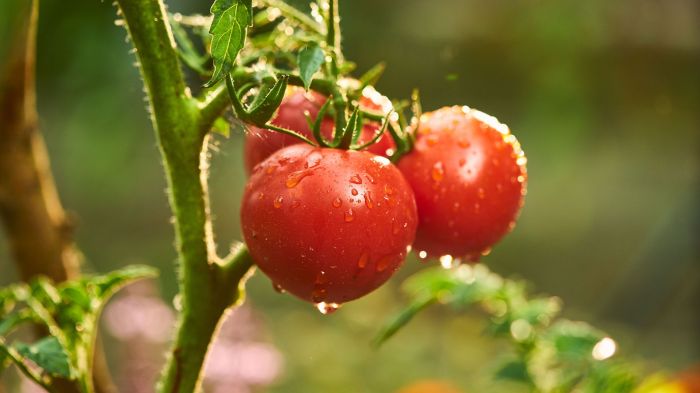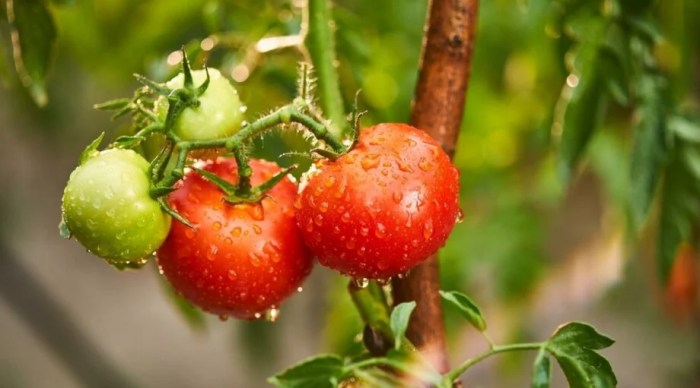How Much Should You Water Your Tomato Plants?
Factors Affecting Tomato Plant Watering Needs
How much should you water your tomato plants – The amount of water your tomato plants require depends on several interconnected factors. Understanding these factors is crucial for maintaining healthy, productive plants.
Soil Type and Watering Frequency
Different soil types retain water at varying rates. Sandy soils drain quickly, requiring more frequent watering, potentially even daily during hot, dry spells. Clay soils, conversely, retain water longer, reducing the need for frequent watering. Well-draining loam soils offer a good balance, requiring moderate watering.
Sunlight Exposure and Hydration

Source: futurecdn.net
Plants in full sun (6-8 hours daily) transpire more water than those in partial shade (4-6 hours). Increased sunlight exposure necessitates more frequent watering to compensate for the higher rate of water loss through evaporation.
Watering Needs of Different Tomato Varieties
While general guidelines exist, specific tomato varieties have slightly different water requirements. Larger, indeterminate varieties (those that continue to grow throughout the season) generally need more water than smaller, determinate varieties (those that stop growing after a certain point). Always check the plant tag or seed packet for specific recommendations if available.
Temperature and Humidity’s Influence on Water Requirements
High temperatures and low humidity accelerate water loss through transpiration. Conversely, cooler temperatures and higher humidity reduce the plant’s water needs. During heat waves, increase watering frequency; during cool, humid periods, reduce it.
Recommended Watering Schedules
| Soil Type | Sunlight Exposure | Temperature (°F) | Watering Frequency (approx.) |
|---|---|---|---|
| Sandy | Full Sun | 90+ | Daily or every other day |
| Loam | Partial Shade | 70-80 | Every 2-3 days |
| Clay | Full Sun | 80-90 | Every 3-4 days |
| Sandy | Partial Shade | 60-70 | Every 3-4 days |
Watering Methods and Techniques
Choosing the right watering method significantly impacts your tomato plants’ health and yield. Efficient watering techniques conserve water and promote healthy root development.
Watering with a Watering Can
A step-by-step guide for watering tomatoes with a watering can:
- Water deeply at the base of the plant, avoiding wetting the leaves to prevent fungal diseases.
- Water slowly, allowing the water to soak into the soil. This ensures deep root penetration.
- Water in the morning or evening to minimize evaporation.
- Check the soil moisture regularly by inserting your finger a few inches into the soil. Water when the top inch feels dry.
Drip Irrigation System Setup
Setting up a drip irrigation system involves placing emitters or drippers near the base of each plant. This delivers water directly to the roots, minimizing water waste and preventing leaf diseases. Consider using a timer for automated watering.
Soaker Hoses: Benefits and Drawbacks
Soaker hoses provide a gentle, consistent watering method. Benefits include even moisture distribution and reduced evaporation. However, they can sometimes clog, and may not be ideal for all soil types or plant spacing.
Deep Watering vs. Frequent Shallow Watering
Deep watering encourages deep root growth, making plants more drought-tolerant. Frequent shallow watering, on the other hand, encourages shallow roots, making plants more susceptible to drought stress. Aim for infrequent, deep watering.
Infographic: Proper Watering Techniques
Signs of Underwatering and Overwatering
Recognizing the signs of underwatering and overwatering is crucial for maintaining healthy tomato plants. Early detection allows for prompt corrective action.
Visual Cues of Underwatered Plants, How much should you water your tomato plants
- Wilting leaves
- Dry, brittle soil
- Leaf curling
- Stunted growth
Symptoms of Overwatered Plants
- Yellowing leaves
- Soggy soil
- Root rot (indicated by a foul odor)
- Leaf drop
Comparing Underwatering and Overwatering Effects
Underwatering leads to wilting, stunted growth, and reduced fruit production. Overwatering causes root rot, fungal diseases, and ultimately, plant death. Both extremes negatively impact plant health.
Diagnosing Watering Problems
Diagnosing watering issues requires careful observation of plant symptoms and soil conditions. Combining visual cues with soil moisture checks will provide a clearer picture of the problem.
- Wilting leaves and dry soil: Underwatering. Increase watering frequency and depth.
- Yellowing leaves and soggy soil: Overwatering. Reduce watering frequency and improve drainage.
- Stunted growth and dry soil: Potential nutrient deficiency or underwatering. Test soil nutrients and adjust watering accordingly.
Seasonal Watering Adjustments
Watering needs change throughout the growing season, requiring adjustments based on weather conditions and plant growth stage.
Watering Needs Across the Growing Season
Spring requires less frequent watering as the soil is typically moist. Summer necessitates more frequent watering due to increased heat and evaporation. Fall watering needs decrease as temperatures cool and rainfall may increase.
Watering tomato plants depends on several factors, including soil type and weather. Generally, aim for consistently moist soil, but avoid waterlogging. Understanding the frequency is key, and this relates directly to the broader question of how often to water indoor plants in general; for more detailed guidance on this, check out this helpful resource on how many times to water indoor plants.
Applying this knowledge, you can better determine the appropriate watering schedule for your thriving tomato plants, ensuring they receive just the right amount of moisture.
Extreme Heat and Drought
During extreme heat or drought, increase watering frequency to compensate for increased water loss. Consider using mulch to retain soil moisture.
Seasonal Watering Schedule
A general guideline for seasonal watering adjustments (adjust based on your specific climate):
- Spring: Water every 3-5 days, depending on rainfall.
- Summer: Water daily or every other day, especially during heat waves.
- Fall: Water every 3-5 days, reducing frequency as temperatures cool.
Role of Mulch in Water Conservation
Mulching helps retain soil moisture, reducing the frequency of watering. A layer of organic mulch, such as straw or shredded leaves, slows evaporation and moderates soil temperature.
Adjusting Watering Based on Rainfall
Monitor rainfall amounts and adjust your watering schedule accordingly. Reduce watering frequency during periods of significant rainfall.
Troubleshooting Common Watering Issues: How Much Should You Water Your Tomato Plants
Addressing common watering problems promptly ensures healthy tomato plants and bountiful harvests.
Uneven Watering in Raised Beds or Containers

Source: epicgardening.com
Ensure even watering in raised beds by using a soaker hose or drip irrigation system. For containers, check for adequate drainage holes and water thoroughly until water drains from the bottom.
Preventing Fungal Diseases
Avoid overhead watering to prevent fungal diseases. Water at the base of the plant to keep foliage dry.
Addressing Nutrient Deficiencies
Nutrient deficiencies can mimic symptoms of underwatering. Conduct a soil test to identify nutrient deficiencies and amend the soil accordingly.
Adjusting Watering Based on Plant Age and Size
Young tomato plants require less water than mature plants. Increase watering frequency as plants grow larger and produce more fruit.
Troubleshooting Flowchart
- Problem: Wilting plants.
- Check Soil: Dry? Go to Step 3. Soggy? Go to Step 5.
- Action: Water deeply. Monitor for improvement.
- Result: Improved? Problem solved. Not improved? Check for pests/diseases.
- Action: Reduce watering frequency. Improve drainage.
- Result: Improved? Problem solved. Not improved? Check for root rot.
Expert Answers
What type of watering can is best for tomatoes?
A watering can with a rose head that provides a gentle, even spray is ideal. Avoid using a forceful jet that can damage delicate roots.
Can I overwater tomatoes using drip irrigation?
Yes, even with drip irrigation, you can overwater if the system is not properly adjusted or if the soil doesn’t drain well. Monitor soil moisture to prevent this.
My tomato leaves are yellowing. Is it overwatering or underwatering?
Yellowing leaves can be a symptom of both. Overwatering often leads to yellowing lower leaves and root rot, while underwatering can cause yellowing throughout the plant.
How often should I check the soil moisture?
Check the soil moisture daily, especially during hot and dry periods. Stick your finger a couple of inches into the soil; if it feels dry, it’s time to water.





















